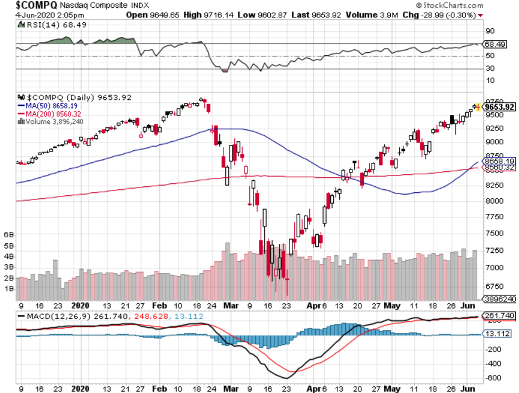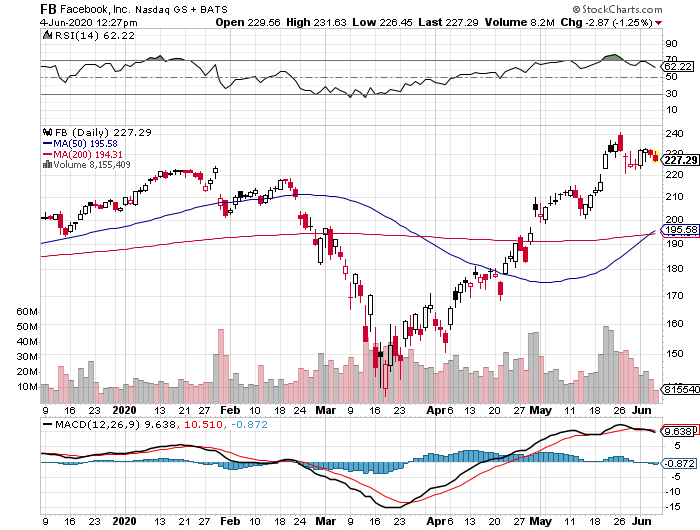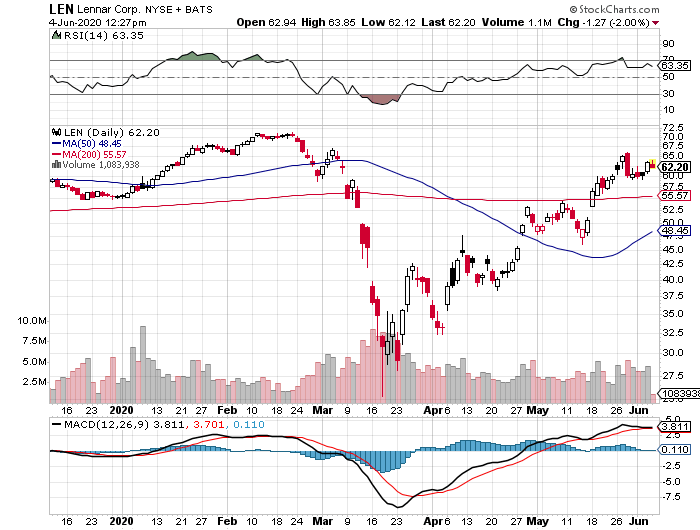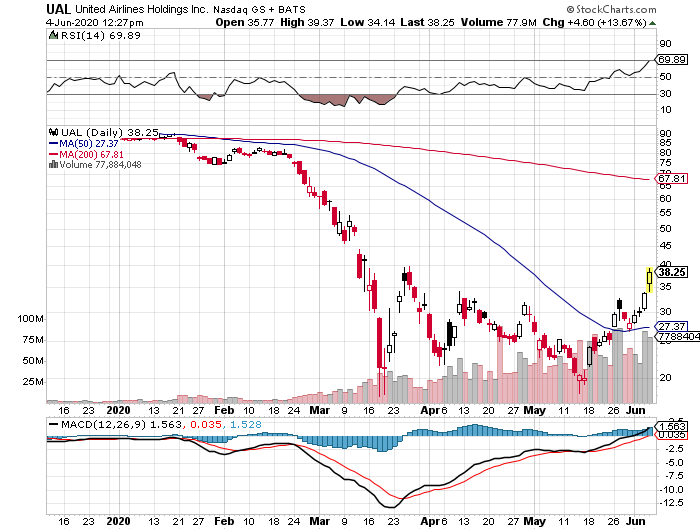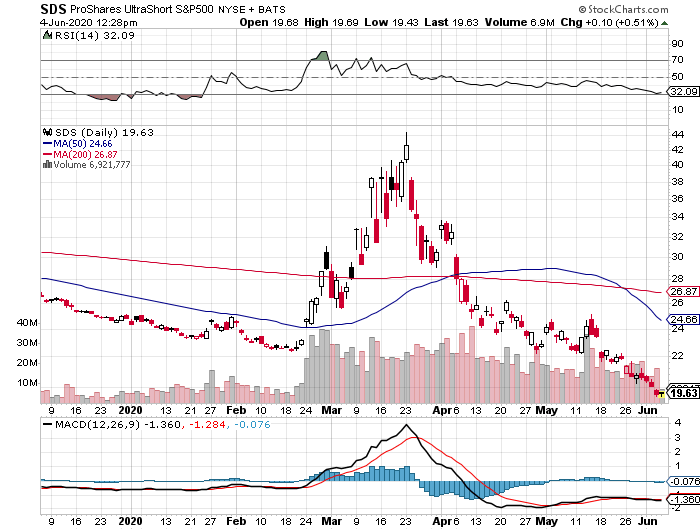When John identifies a strategic exit point, he will send you an alert with specific trade information as to what security to sell, when to sell it, and at what price. Most often, it will be to TAKE PROFITS, but, on rare occasions, it will be to exercise a STOP LOSS at a predetermined price to adhere to strict risk management discipline. Read more
Today, I am going to make one final suggestion and that is to book the profit on the AMN spread.
Here is the trade:
Sell to Close July 17th - $45.00 call @ $6.20
Buy to Close July 17th - $50.00 call @ $3.00
The net credit will be $3.20 per spread. This results in a profit of $1.45 per spread or $870 if you traded the suggested 6 lot.
The return for the four day holding period will be 83%.
Enjoy your weekend and profits from this week.
The PRA suggestion was never intended to be a long term hold, but rather a quick swing trade.
And as such, I am going to suggest you take your profit on the position.
Sell PRA at the market, which is $15.90.
Based on a purchase price of $14.27 four days ago, the return will be 11.4% for those four days.
Mad Hedge Technology Letter
June 5, 2020
Fiat Lux
Featured Trade:
(EUROPE’S BIG TECH TAX GRAB),
(COMPQ), (NFLX), (APPL), (AMZN), (GOOGL), (MSFT)
Big Tech regulation gets the protection of the U.S. government.
The U.S. government has announced that it is looking into aggressive regulation originating from foreign countries that would die to have a FANG themselves.
This is just another salient data point to which tech will lead us through the maze of complexity that the world now finds itself in.
Many jumped on the bandwagon saying it was a matter of time before regulation destroys big tech, but I will argue that big tech has become too big to fail and the value generated from stock appreciation and tax revenue has become even more important.
Tech has been the only industry to not get pummeled by the coronavirus and the ramifications of social unrest.
The U.S. government doesn’t want to tip over the last remaining pillar the U.S. economy is clinging to, they are desperate to allow the U.S. tech models to stay intact.
The Federal and State budgets have massive holes in them and crushing tech’s contribution to the revenue coffers would be political suicide.
Understanding how the administration cherishes big tech means viewing them through the prism of how other countries treat U.S. tech companies hoping to take a piece of the pie themselves through clever “regulation.”
The European Union, the Czech Republic, and the U.K. plan to siphon off tax revenue from big tech even though confronted by possible trade sanctions from the U.S.
The U.S. probe also will look into the digital services tax plans of Austria, Brazil, Indonesia, Italy, Spain, and Turkey because they are all looking to skim some cash off of big tech’s cash cow.
To read more about the tax fiasco, please click here.
Europe and the emerging economies have been hit harder than the U.S., not in terms of deaths, but in relative economic terms because they don’t possess the rolodex of Fortune 500 companies that can just issue more corporate debt or a Fed central bank that is delivering trillions in liquidity that has saved the stock market.
Washington has specifically been eying up France for a section 301 investigation after it became the first country to fully implement a digital sales tax in July 2019.
France has been quite aggressive in calling out big tech for undermining and exploiting their economy by not paying tax due.
French Finance Minister Bruno Le Maire has been sharp-tongued criticizing America’s big tech companies for running wild in European markets.
A 3% digital sales tax was in the cards before the U.S. slapped on a counter tariff to French goods which delayed the frosty confrontation.
Europe’s vast network of splintered resources and unbalanced innovation combined with Europe’s infamous avalanche of bureaucracy meant that developing a famous tech company fell through the cracks.
Nothing even remotely close to Silicon Valley was ever conjured up inside the confines of the European Union.
The consequences have been costly with most Europeans relying on Apple cell phones, Google software, Netflix subscriptions, and Microsoft enterprise products to get them through the day just like most Americans.
The tax grab is out of desperation as the EU confronts a post-coronavirus world where they are increasingly controlled by decisions from the Communist Chinese and subject to a graying population that delivers a reduced tax revenue base.
The European Union is one of the biggest losers from the coronavirus.
The hands-off warning by the U.S. government on its own big tech companies puts a premium on their existence to the U.S. economy.
Instead of twisting their arm to squeeze every extra tax dollar out of them, they will most likely get more access to deliver the services most Americans are hooked on.
It’s not a secret that current U.S. President Donald Trump is hellbent on destroying big tech but there is no way to do it without destroying the U.S. economy and the U.S. stock market.
At this point, just a handful of tech companies comprises over 22% of the S&P and this will most likely continue as other industries are still licking their wounds with some analysts believing it will take 10 years to get back to late 2019 economic levels.
The most likely scenario for big tech is that the array of crises has delayed real regulation indefinitely and the U.S. will protect big tech from a tax grab abroad.
The best-case scenario is zero regulation leading to zero extra costs.
Either way, stock appreciation is in the cards for tech’s future.
The end result is that big tech could eventually comprise up to 30% of the S&P in the next 3 years which dovetails nicely with a recent analyst call that Microsoft will hit over $2 trillion in market capitalization in the next 2 years.
“Broadcast TV is like the landline of 20 years ago.” – Said Founder and CEO of Netflix Reed Hastings
When John identifies a strategic exit point, he will send you an alert with specific trade information as to what security to sell, when to sell it, and at what price. Most often, it will be to TAKE PROFITS, but, on rare occasions, it will be to exercise a STOP LOSS at a predetermined price to adhere to strict risk management discipline. Read more
Global Market Comments
June 5, 2020
Fiat Lux
Featured Trade:
(JUNE 3 BIWEEKLY STRATEGY WEBINAR Q&A),
(FB), (M), (UAL), (LVS) , (WYNN), (MS), (SPX), (TBT), (TLT), (AAPL), (FB), (MSFT), (SDS), (SPX), (AMZN) (LEN), (KBI), (PHM), (TSLA)
Below please find subscribers’ Q&A for the June 3 Mad Hedge Fund Trader Global Strategy Webinar broadcast from Silicon Valley, CA with my guest and co-host Bill Davis of the Mad Day Trader. Keep those questions coming!
Q: Domino's Pizza (DPZ) is at all-time highs? Would you buy this name right here, right now?
A: No, I would not even buy their pizza. You would be crazy to buy them right now up here this high. I prefer Round Table, the pizza not the stock. All of these “reopening” stocks are way overextended.
Q: Will the riots delay the recovery?
A: Yes, they will, it could take as much as another 1% off the current GDP growth rate. It’s hitting the already worst-hit sector—retailers. Many retailers will not come back from these, especially the small ones. These businesses were just returning from being closed for two months when they got burned down. But we won’t see it in the macro data for many months because its happening largely at the micro level. If you didn’t like Macy’s (M) before when it was headed for Chapter 11, you definitely won’t like it now that it is burning down.
Q: If airlines like United Airlines (UAL) can’t use the middle seat, do you see ticket prices going up 10%, 25%, or 50%?
A: Yes. In theory, to just cover the middle seat, they have to increase prices 33%. And there will be a whole lot of new costs that the airlines have to endure as part of this pandemic, such as extra cleaning, disinfecting, and temperature taking. So, they’re really going to need to increase prices by 50% or more just to break even. My guess is that the airline industry will shrink in half in the fall when all the government bailout money runs out. So, I've been telling people to take profits on the airlines, especially if you have a double or triple in them, or if you have the LEAPS.
Q: Is Facebook (FB) immune from any big selloff?
A: No, nobody is immune—look how much Facebook sold off in March, some 35%. Mark Zuckerberg seems to be making a deal with the devil, accommodating the president with unrestricted incendiary Facebook posts. And the consequences of a Democratic win for Facebook could be hugely negative, so I am not participating in that one. Mark doesn’t have a lot of friends in congress right now so regulation looms.
Q: What do you think about buying Las Vegas Sands (LVS) or Wynn Resorts (WYNN) on the expectation of reopening?
A: I’m a Nevada resident and get frequently updated on the casino news. They’re only going to be allowed half of peak casino visitors that they had in January, so they will generate huge losses. Almost all companies are being allowed to reopen back to half the level that guarantees bankruptcy in 3-6 months. But we won’t see that in the numbers for many months either. I’m negative on any industry that depends on packing people in, like airlines, cruise lines, and movie theaters.
Q: What are the chances of a mass student debt cancellation?
A: That is a possibility if the Democrats win in November, and it has already been proposed. It is about a $1.5 trillion ticket. If you’re bailing out large companies, small companies, airlines, and the oil industry, why not students? It would have the benefit of adding 10 million more consumers to the economy, who are not current participants because they have massive student debts that are appreciating at 10% a year and have terrible credit ratings. So that would be another great economic stimulus measure. By the way, I paid off my student loans 40 years ago in a lump sum payment with my first paycheck from Morgan Stanley (MS). How much did four years of college cost during the 1960s? $3,000. Such a deal.
Q: What’s the next resistance level on the S&P 500 (SPX)?
A: The target we’ve been looking for is $3,125. I’m looking for roughly $40 points above that level—it should be about $3,165. We’re in uncharted territory here because nobody’s ever seen a market rise 40% in two months, so any technical recommendation has to be bearish except for a very short term, like intra-day or daily views.
Q: Any correlation between the 1918 epidemic and now?
A: Here is your History of Virology Lesson 101 for today. There is some similarity, but the 1918 flu actually originated on a farm in Kansas, had a 2% death rate, took a trip to Europe, mutated, came back months later, and then had a death rate of 50%. We haven't seen that second wave yet, or major mutations. We have seen a couple of different DNA strands out there though, meaning we would need multiple different vaccines when we get them. By the way, it was called the “Spanish Flu” because during WWI, every country had censorship except Spain because it was not a combatant. So, the pandemic was only reported in the Spanish newspapers.
Q: Would you get out of any of the previously recommended LEAPS?
A: Yes, I would be taking profits on all of your LEAPS—whether tech, domestic, “recovery”, or whatever else—so if we do get a correction over the summer, you can get back in at better prices, with longer expirations. You can go two years out from say August for example. The risk/reward today is terrible.
Q: Would you hold on to the (SDS) right now, or wait for the pullback
A: No, we have offsetting profits on all of our (SDS) positions, until today—if the market keeps accelerating to the upside, SDS losses will start to offset our profits on the positions, so that’s why I would get out.
Q: Should I buy the ProShares Ultra-Short 20 + Year Treasury Bond Fund (TBT)? I don’t do options.
A: You don’t need to do options, (TBT) is an ETF; anybody can buy that, it’s just like buying a stock.
Q: What is happening with the Australian market?
A: It will trade with the US stock market tick for tick, which means they’ve had a fantastic rally, overdue for a selloff. Wait to buy the next dip.
Q: If markets are going to go down soon, why exit the (SDS)
A: It may go up first before it goes down. And in any case, I have a great profit on the combined position of long (SDS) and short bonds. These days, I like taking big profits rather than praying they become bigger. It’s about risk control and knowing what you can get away with in certain market conditions.
Q: Is now the time to sell the highflyers in tech?
A: Yes, I would be selling Apple (AAPL), Facebook (FB), Microsoft (MSFT), and Amazon (AMZN). Get dry powder, which is worth a lot after you’ve seen a move like this; especially if the economy gets worse, which is likely. My late mentor Barton Biggs taught me to always leave the last 10% of a move for the next guy.
Q: At what point do you buy the ProShares Ultra Short S&P 500 ETF (SDS) outright?
A: Only if there is an immediate collapse in the market, which I can’t foresee with any certainty. When you play these bear ETFs, the costs are very high. You are short double the (SPX) dividend, which is about 5% a year, plus hefty management fees. So, you really have to catch a quick, large move to the downside to make any real money.
Q: Real estate seems like the big winner of the pandemic. Will prices be up by the end of the year or is this just a temporary spike?
A: They will be up at the end of the year. I have been telling readers all year that their home will be their best investment in 2020 and that is coming true. Real estate has a massive tailwind behind it which has really been in place for a couple of years now, and that is the millennials upgrading and buying houses. The pandemic has really poured gasoline on the fire and triggered a stampede out of the city and into the suburbs. Having 85 millennials ready to upgrade their homes is a huge positive for the real estate market, and I’d be looking to buy the homebuilders on any dip. That’s probably the best domestic play out there. Buy Lennar Corp. (LEN) and Pulte Homes (PHM) on dips.
Q: Post pandemic, will manufacturing have any way of helping US economic growth, or is bringing back the supply chains fake news?
A: It is fake news because if companies bring back production, it will be machines and not people making things. Unless you want to pay $10,000 for an iPhone, or $5,000 for a low-end laptop. Oh yes, and the stocks which made these things would be 90% lower as well. That’s what those products cost in today’s dollars if they were made in the United States. I wouldn't count on any repatriation of US jobs unless people want to work for $3 a day like the Chinese do. Offshoring happened for a reason.
Q: How do I hedge a municipal bond portfolio?
A: You might think about taking profits in muni bonds. They’re yielding around 2% and change. And they could get hit with a nice little 20-point decline if the US Treasury bond market (TLT) falls apart, which it will. Then you can think about buying them back. If you really want to hedge, you sell short the (TLT) against your long muni bond portfolio. But that is an imperfect hedge because the default rate on munis is going to be much higher than it is now than it was in 2008-2009, and much higher than US Treasuries, which never defaults despite what the president has said.
Q: What is dry powder?
A: It means having cash to buy stocks at market bottom. In the 1800s before cartridges were invented, black powder got wet whenever it rained causing guns to fail to shoot. That is the historical analogy.
Q: What do we do now if we’re getting started?
A: It will require a lot of discipline on your part as coming in at market tops is always risky. Wait for the next trade alert. Every one of these is meant to work on a standalone basis. I would do nothing unless you see one of these things happen; any 2 or 3-point rally in bonds (TLT), you want to sell short. We’re just at the beginning of a multiyear trade here so it’s not too late to get back into that. Gold (GLD) is probably safe to buy on the dip here since we are at the very beginning of a historic expansion of the global money supply. I wouldn’t touch any stocks unless we get at least a 10% drop and then I'll start putting out call spread recommendations on single stocks. But right here, on top of the biggest bounceback in stocks in market history, don’t do anything. Just read the research and make lists of things to buy when they do dip—something I do for you anyway.
Q: What about Beyond Meat (BYND)?
A: The burgers are not that bad, but the stock is way overpriced and you don’t want to touch it. It's one of the fad stocks of the day.
Q: Can we access the slides after the webinar?
A: Yes, we post it on the website under your “Account” section about two hours after we’re done.
Q: Are you saying sell everything currently profitable?
A: Yes, I would be selling everything on a short term basis, keep tech and biotech on a long term basis. We are the most overbought in history and you don’t get asked twice to sell tops. But yes, it could go higher before the turn happens. From a risk-reward point of view, it’s terrible to do anything right now.
Q: Could we get a pullback to the $260-$270 area in the S&P 500 (SPY)?
A: Yes, especially if we get a second worse wave of corona and the stimulus takes much longer than we thought to get into the economy, or if the rioting continues.
Q: Should you sell CCI now?
A: Yes, I actually would. You have a 57% gain in the stock in ten weeks, so why not? Long term, it’s a hold.
Q: Are any retail stocks a buy?
A: No, they aren’t because a lot of them are going to go under but you don’t know which ones. After shutting down and losing 60% of their revenues, they’re now being burned down. The pros who do well in the sector are bankruptcy specialists who have massive research teams that analyze every lease in every mall and then cherry-pick. You and I don’t have the ability to do that so stay away.
Q: What is the best way to play real estate?
A: Buy a house. If not, then you buy (LEN), (KBI), and (PHM).
Q: Is it too late to get back in the stock market?
A: Yes, I'm afraid it is. Buying, because it has gone up, is a classic retail investor mistake. After this meltdown, maybe you will learn to buy stocks when everyone else is throwing up on their shoes. That's what I was doing in March and we got returns of 50% to 100% on everything and 500% to 1,000% on the LEAPS (TSLA).
Q: Are you buying puts?
A: No, I am not taking outright short positions any more than I have now because we have a Fed-driven melt-up underway with a stimulus that's 20x larger than that seen during the 2008-2009 Great Recession. When I don’t know what’s going to happen, I get out.
Good Luck and Stay Healthy.
John Thomas
CEO & Publisher
The Diary of a Mad Hedge Fund Trader
When John identifies a strategic exit point, he will send you an alert with specific trade information as to what security to sell, when to sell it, and at what price. Most often, it will be to TAKE PROFITS, but, on rare occasions, it will be to exercise a STOP LOSS at a predetermined price to adhere to strict risk management discipline. Read more
Legal Disclaimer
There is a very high degree of risk involved in trading. Past results are not indicative of future returns. MadHedgeFundTrader.com and all individuals affiliated with this site assume no responsibilities for your trading and investment results. The indicators, strategies, columns, articles and all other features are for educational purposes only and should not be construed as investment advice. Information for futures trading observations are obtained from sources believed to be reliable, but we do not warrant its completeness or accuracy, or warrant any results from the use of the information. Your use of the trading observations is entirely at your own risk and it is your sole responsibility to evaluate the accuracy, completeness and usefulness of the information. You must assess the risk of any trade with your broker and make your own independent decisions regarding any securities mentioned herein. Affiliates of MadHedgeFundTrader.com may have a position or effect transactions in the securities described herein (or options thereon) and/or otherwise employ trading strategies that may be consistent or inconsistent with the provided strategies.



